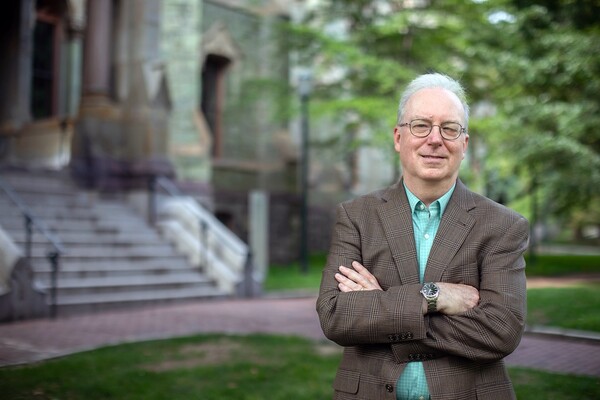
nocred

Following a yearlong evaluation and inclusive process, the name of Roger Brooke Taney, former chief justice of the United States Supreme Court, will be removed from a decorative medallion adorning the exterior of historic Silverman Hall at the University of Pennsylvania Carey Law School.
The decision comes after a formal process led by the Taney Medallion Task Force, formed by Dean Theodore Ruger in May 2021. Ruger charged the committee to study the history of how Taney’s name came to be memorialized on the building and to recommend whether to retain it. The Law School, he said, is committed to anti-racism as part of its dedication to justice and equality under law.
Following the task force’s work, Ruger accepted its recommendation to remove Taney's name from the decorative medallion. In February, then-President Amy Gutmann approved Ruger’s recommendation, guided by the framework put forward by the Campus Iconography Group (CIG).
The inclusion of Taney’s name on the building has long baffled and bothered many students and faculty of the Law School, as Taney wrote the majority opinion in the infamous 1857 Dred Scott case, which upheld slavery and denied that people of African heritage could become citizens of the United States.
The case was deeply controversial at the time and was a significant factor in the Civil War that began only four years later. Dred Scott is regarded as the nadir of proslavery jurisprudence and was overruled by the 14th Amendment, which grants citizenship to all those born or naturalized in the U.S., providing for equal protection of the law for all citizens.
The task force, chaired by Sarah Barringer Gordon, Arlin M. Adams Professor of Constitutional Law and professor of history, was composed of Law School staff, students, alumni, and faculty. Committee members researched Taney’s background, organized community meetings about the medallion, and encouraged public input on whether to recommend that Taney’s name should remain on the building or be removed.
“We approached our charge with a very open mind, investigating the history of the building and the message that such medallions send to our community, and trying to learn more about how this particular decision was made,” Gordon says. “We consulted with current and former students, colleagues, and community members and pored over scholarship on the Dred Scott case and its author.” Among the questions the committee attempted to answer were what connections Taney may have had to the University and what the prominent display of his name symbolizes.
Silverman Hall was the first Law School building on the campus in West Philadelphia and was dedicated in February 1900. The exterior is lined on all four sides with decorative limestone shields and medallions bearing the last names of legal luminaries. The task force learned that the names were selected by a committee composed of faculty and trustees, with final approval from Judge John Clark Hare, an emeritus member of the faculty, according to a final report by the medallion task force.
However, they found there was no discussion in those materials about how Taney was chosen to have a medallion on the building. Nor was there evidence there or elsewhere in the historical materials associated with the building that Taney had any connection to the University of Pennsylvania.
Taney came from a prominent family in Maryland that held generations of people in slavery on their tobacco plantation, according to the report. He studied law at Dickinson College and went on to be attorney general of Maryland before serving in the administration of President Andrew Jackson, eventually holding the cabinet position of U.S. attorney general. Jackson later nominated him for the Supreme Court, where he was the fifth chief justice. Early in his life, Taney apparently opposed enslavement and freed those he held as slaves in 1818. By the early 1830s, however, his position had changed. He became an increasingly doctrinaire supporter of slavery and believed that his opinion in Dred Scott would end debates over slavery. Taney’s opinion produced the opposite result, however. Rather than ending debates, the ruling provoked immediate and sustained criticism. Dred Scott was a key factor in Abraham Lincoln’s campaign for president in 1860, as well as an important factor in the outbreak of the Civil War in 1861.
In November 2021, the task force submitted to Ruger its unanimous recommendation that the Law School chisel Taney’s name off the medallion. A replica will be created and displayed in the Biddle Law Library, along with explanatory material associated with the building and the Dred Scott case. The task force recommended that a minimum 10 years should pass until a decision is made on what name, if any, should replace Taney’s on the exterior.
“The medallions on historic Silverman Hall were selected more than 120 years ago to inspire those who study in our buildings. With that goal in mind, and with the University’s encouragement, the committee I appointed did a deep dive into Roger Taney’s history and engaged the full Law School community in discussion. The Committee recommended a plan that encourages action and education,” Ruger says.
The Law School isn’t the first entity in Philadelphia to take on Taney’s legacy and remove his name. The Taney Dragons took the Little League World Series by storm in 2014, with their underdog status and star 13-year-old girl pitcher Mo’ne Davis. The team decided to change their name to the Philadelphia Dragons in 2020 to eliminate the reference to the controversial jurist. And there is an ongoing effort to rename the city’s Taney Street after African American activist and scholar Caroline LeCount. Other commemorations to Taney have been removed in Annapolis and Baltimore in Taney’s native Maryland and from the national House of Representatives in Washington, D.C.
The decision to remove Taney’s name is just one of the ways that schools and departments around campus are taking a fresh look at iconography, says Joann Mitchell, senior vice president for institutional affairs and chief diversity officer.
The Campus Iconography Group, which convened in 2020, was charged with considering issues of representation through art and symbols, particularly those considered to conflict with Penn’s values. That group, co-chaired by Mitchell and Frederick Steiner, dean of the Stuart Weitzman School of Design, developed frameworks that lay out criteria for removing such artworks from campus grounds, as well as a set of guidelines for new acquisitions.
The Taney task force used the CIG framework in drawing up its recommendation.
“The Law School has been amongst the leaders in trying to look carefully at the imagery and the messages that it's sending to their students, applicants, and staff,” Mitchell says, pointing to the Law School’s recent efforts to highlight more diverse portraiture in their buildings.
The decision to remove Taney’s name “was not just a knee jerk reaction,” says Mitchell. “It was a long, thoughtful process that was inclusive. They submitted a detailed report outlining how it comported with the criteria established by the Campus Iconography Group.”
Steiner says the CIG framework was intended to help schools and departments assess a whole person, and especially the whole person’s contribution to Penn.
“We hope that the process of considering any removal will be thoughtful and deliberate, and the task force’s recommendation certainly was,” Steiner says.
The Taney Medallion Task Force focused on setting up a process that would allow for a variety of responses and feedback. They held community meetings, set up an email address to take comments, met with student groups, and talked with staff and faculty.
“Overwhelmingly, the vast majority of students, faculty, staff, and alumni said it really is past time for us to not have this be the message we send the world,” Gordon says. “Almost everyone who met with us or sent us messages or spoke over the phone, said they felt it was inappropriate that his name was honored in ways that had been proven by history not to be justified.”
Taking the medallion down would be difficult, since it weighs nearly a ton. One medallion was taken down due to a construction project a few years ago and did survive intact, which was more or less pure luck, Gordon says. Architects cautioned it was not guaranteed the Taney medallion could remain intact if removed.
Because of its location some 30 feet off the ground, the option of adding a plaque next to the name to contextualize Taney’s inclusion on the building and history wasn’t an option, Gordon says.
They only heard from two individuals, both students, who opposed removing the name, Gordon says. One said the effort was too drastic; the second noted that Taney was the first Roman Catholic Supreme Court justice and thought the removal might send an anti-Catholic message. Gordon looked into that concern and found that there were very prominent Catholic critics of the Dred Scott decision at the time, one of whom accused Taney of not adhering to Catholic principles.
Gordon says one of the aspects of the research that was most important to the way the committee thought about Taney’s medallion was the work of the Monument Lab, the public art and history studio that grew out of research at the Weitzman School, which did a survey of monuments in the United States. They found that about 3,000 Civil War monuments were put up between 1890 and 1920 and they were overwhelmingly dedicated to pro-slavery politicians, judges, and Confederate officers.
“This medallion to Taney falls squarely in that 30-year period,” she says. “We have this lopsided commemorative landscape that was put in place not as events unfolded but decades after the Civil War ended with the abolition of slavery. Such works send an inaccurate picture. Taney’s name doesn't accurately represent our legal system and our goals for justice.”
Taney died in 1864, during the Civil War, 36 years before his name appeared on Silverman Hall.
“The idea is not to erase all mention of Taney but to send a message from the outside of our building that doesn't endorse human bondage and racism. We don’t want to deny Taney was on our exterior and that many people in the Jim Crow era valorized a ‘Lost Cause’ version of the Civil War. But we certainly don't want to endorse that false interpretation,” Gordon says, adding they want students and visitors to understand that they see clearly what it meant to have Taney’s name on the building and preserving that is part of being true to the Law School’s history.
“We don't want to erase the past, and we will work with our wonderful Biddle Law librarians to create a more carefully contextualized understanding of who Taney was and why his decision was so important to American history,” she says. “But we also are committed to projecting a more accurate and inclusive vision on the exterior walls of our first Law School building, which commemorate great legal thinkers.”
Kristen de Groot

nocred

Image: fcafotodigital via Getty Images

Image: Mininyx Doodle via Getty Images

Charles Kane, Christopher H. Browne Distinguished Professor of Physics at Penn’s School of Arts & Sciences.
(Image: Brooke Sietinsons)